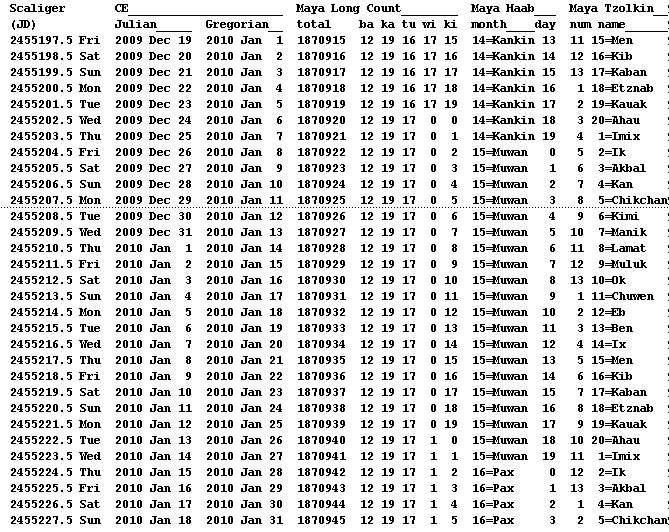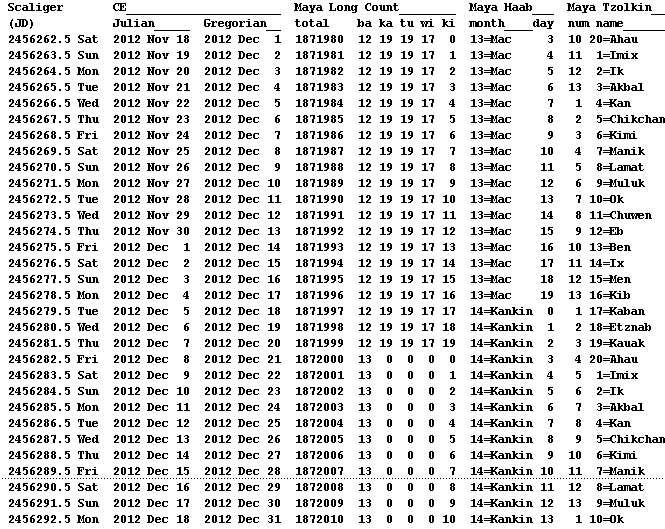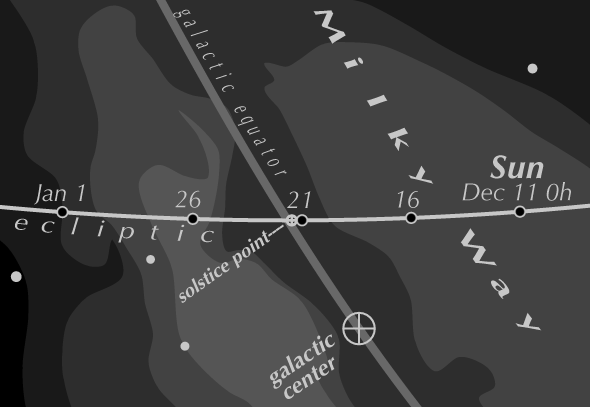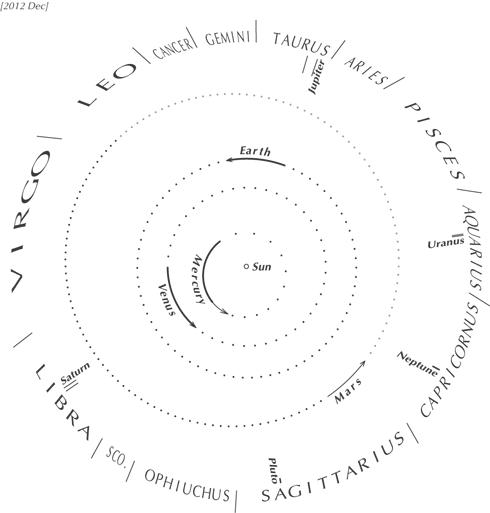Universal Workshop

books etc. by
Guy Ottewell
|
More about the Mayan calendar and the 2012 "End of Time" The Long Count by which the Maya measured history is justly famous, and I didn't say enough about it. Being out of touch with popular culture, and behind in reading the magazines, I wasn't aware of the cosmic fears developing about the year 2012. That I had just traveled in Mayaland and thought of writing about the calendar was a lucky coincidence that should have been crowned with a good laugh at the absurdity of these fears, but I didn't realize it. Then there was a smaller error to which I have to admit, and which you may think undermines any authority in what I say about the Maya calendars. I did put two days into grasping the mathematics, but this was early in 2009 and was not quite enough. Fortunately only a few of the figures in two columns of my table of Maya dates for January 2010 have to be changed. The book from which I learned is Calendrical Calculations (Cambridge University Press, 1997) by Nachum Dershowitz and Edward M. Reingold, both of the Department of Computer Science, University of Illinois at Urbana-Champaign. They pointed out that the days of the Haab months were numbered from 0, not 1. Strangely, they had not mentioned that this is true also of the Long Count units. Though there are 20 kin in a winal, each 20th is numbered not 20 but 0; similarly, though there are 18 winal in a tun, each 18th is numbered not 18 but 0. (And likewise for the larger units tun, katun, and baktun.) So here is the table corrected (and improved in a few other ways). The corrections are that our Jan. 6 and 26 are kin 0, not 20; and Jan. 6 to 25 constitute a winal 0, not 18. (Ba ka tu wi ki stand for baktun, katun, tun, winal, kin.)
These must be accurate at least in the sense of coinciding with Dershowitz and Reingold, since I have checked my programming with all 33 of the dates (from 587 BC to 2094 AD) used as samples in the appendix of their book. Here is the beginning of the Long Count, in 3114 BC (written mathematically as –3113):
And here is a table for the future month about which there is so much excitement, December 2012:
Between Dec. 20 and 21 of our calendar, the Long Count rolls into "a string of zeros, like the odometer turning over on your car", as E.C. Krupp puts it in his amusing article about "The Great 2012 Scare", for the November 2009 issue of Sky & Telescope. This is the end of one baktun and the beginning of another; so the component katuns, tuns, winals and kins all start again at 0. The baktun that is ending bears the number 12, but it is the 13th since the start-date of the Long Count, since the first was numbered 0. What the 2012 Scaremongers are claiming is: —The end of this 13th 144,000-day baktun is the end of the Mayan calendar, or of a huge cycle in it. —"Thirteen was a sacred number for the Maya." —Also on 2012 Dec. 21 the sun comes to its winter solstice point; and, in 2012, that point will be "aligned with", indeed will "eclipse", the center of our Milky Way galaxy. —And, for good measure, the planets will on that date be "lined up". —All this will cause our planet to be devastated, or possibly renewed. (By any or all of many imaginable drastic mechanisms: flood, earthquake, cosmic impact, nuclear war, electromagnetic fields, spiritual energy?) —The Maya foresaw this, and that's why, inventing their calendar sometime after 200 AD, they set the starting-date for their Long Count where they did in 3114 BC. Apparently they knew that time would reach an "end" exactly 1,872,000 days after that date. —And, to quote one of the commentators: ". . . humanity is creating its own ecological disasters and desperately needs ancient indigenous wisdom." Well . . . The most obvious flaw is that the end of the 13th baktun is no more significant than the end of the 12th (on 1618 Sep. 17) or the 14th. The next larger cycle, called a piktun, is composed not of 13 but of 20 baktun. The Maya did apparently believe that the world is destroyed and remade at the turn of each piktun. (Our present world, then, would date from 3114 BC.) But there will be 7 more baktun — 7 times 144,000 days, or about 2,760 years — till the end of the current piktun. No cause for anxiety now, but in the year 4772, if people still exist and are still as silly, there may be a more plausible scare:
As to whether the number 13 was "sacred": in Maya arithmetic and certainly in the calendar systems the dominant number is 20. In the Long Count all the factors are 20 or 18; in the Haab calendar, also 20 and 18; in the Tzolkin, 20 and 13. What about the December solstice? It is the moment when the earth's north pole is tilted most away from the sun (giving midwinter for our northern hemisphere, midsummer for the southern). The sun appears to travel along the ecliptic, a great circle that has to cross every other great circle at two points, and one of these great circles is the galactic equator, or midline of the Milky Way. In 2012 the instant of the solstice is Dec. 21 11h 11m Universal Time. The solstice point, like all points on the ecliptic, moves slowly westward (rightward), by about 1/72 of a degree per year, because of precession (change in direction of the earth's axis). The claim is that in 2012 it will have arrived at the exact point where the ecliptic crosses the galactic equator. This will last have happened 25,800 years ago (the length of the precessional cycle).
This might be true (more probably not: I figure the solstice point actually passed across the galactic equator in 1998). But it would be true in the same sense as being in the precise center of a river, or of a hank of cotton wool. The galactic equator is the midline of the Milky Way as seen from earth. The Milky Way's edges fade outward like those of a cloud of steam, a very irregular one. (The midline is partly traced, also very irregularly, by dark dust-clouds.) The galactic equator, used by astronomers for specifying positions of objects in the galaxy, is defined by convention, and has been defined in at least two ways (the "old" or "Ohlson" and the "new" or "IAU"). It is not entirely arbitrary, because the position of the radio source at the galaxy's center is known. The equator represents roughly the "plane" of the galaxy as we look out through its vast disk of stars. But the sun is thought, with great uncertainty, to lie now about 26 light years north of the physical midplane; so it is a plane in which we do not ourselves lie. And the point where the ecliptic crosses the galactic equator is not the same as "the center of the galaxy". That is about 6.6 degrees southwest along the galactic equator. So the half-degree-wide sun is never in the same direction as — can never "eclipse" — that center. (It is a degree or so nearer a couple of days earlier.) And what possible effect could there be on a planet at that moment just because its north pole is tipped in a certain direction away from its star? The center of the galaxy is about 28,000 light years away — getting on for 2 million times as far from us as the sun. Imagine two specks of soil in your yard, an inch apart, going into special convulsions because of the influence of a stone 28 miles away, when there are billions of other bits of soil in between. And will the planets be "aligned" in December 2012? No, they will be scattered in pretty random directions.
As for "ancient indigenous wisdom": it appears that the Maya of more than a thousand years ago were remarkably clever but not outstandingly wise. Maya civilization collapsed from about 900 AD onward because of ecological foolishness, habitual war, and a luxurious and cruel ruling elite; population crashed. If they didn't see that coming, they are unlikely to have made reliable predictions about the world of centuries later. Worry about the very real threats to our planet from human numbers and over-consumption — especially, atmospheric heating, ocean acidification, and the second most rapid extinction of species in the planet's history. Don't worry about yet another in the long line of panics concocted by pseudo-scientists. |





